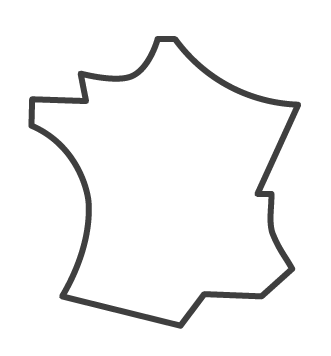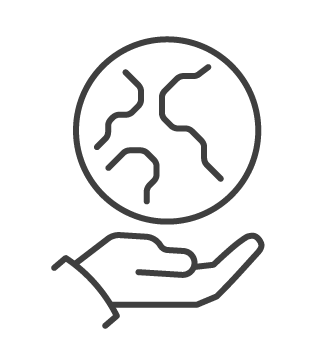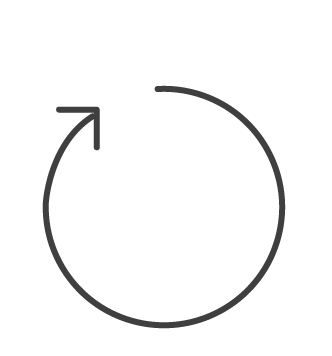The new leathers
Animal leather, the end of an era
Leather is part of a tradition and a culture that are dear to us. This material is still today the emblem of a know-how of which France has always carried the colors high. But analyzed through the lense of today's climate and environmental issues, the reality of the "virtues" of leather is much less flattering than the beliefs deeply rooted in the collective unconscious would suggest. And the former glory of this material cannot hide its very negative impact on our planet.
Presenting leather as a sustainable material in essence, because if the skin was not exploited to make leather it would then be thrown away or incinerated, denies the economic reality that surrounds the trade of hides and of an entire industry. Beyond the tanning process itself, raising animals for their exploitation (milk, meat, skins, other outlets) has significant negative impacts on our environment.
Significant contribution to global warming, aggravation of biodiversity loss, major contribution to deforestation, excessive water consumption or the use of numerous chemical products, there are therefore many reasons to question animal leather and to ask about possible alternatives.
While the animal leather industry tries to find solutions to reduce its impact, Maison Maes chooses to foster the spirit of innovation to rethink leather goods today in the light of the challenges of our century and contribute to preserve the environment. By promoting positive innovation, around materials of plant origin, to offer leather goods that are better for the planet.
Different directions, one single objective: to offer a new vision of leather, as qualitative but now responsible
Several approaches exist today, at different degrees of maturity. But all aim at an immediate improvement in environmental impact compared to animal leather.
The culture of animal cells in a laboratory, which could make it possible to obtain "real" skin in 7 to 9 months without harming any animal, seems to offer an interesting approach. But this approach, which remains experimental to date, still requires resorting to tanning and therefore finding other innovative options to avoid falling back into the failings of the current method.
The research on Mycelium is also very interesting. These filaments, which constitute the root-structure of fungi, form particularly dense underground networks and offer very interesting physical properties. In particular, two American companies, MycoWorks and BoltThread, have taken up the subject and are currently working on the development of these new materials, popularized as "mushroom" leathers. However, these products, if they have been highlighted by great collaborations (such as that of Hermès with the company MycoWorks), have not yet reached sufficient commercial maturity to see them quickly transform leather goods.
Today the most mature solutions consist of replicating the “vinyl” leather technique of the 80s and 90s, replacing components derived from petrochemicals with bio-based components. In recent years, we have seen corn, apple, grape, cactus leather flourish... These materials are generally based on the same technique: the use of a textile fabric (cotton, polyester, nylon) on which a biosourced resin is applied, a mix of the announced component and BioPU (polyurethane made from polyols extracted from vegetable oils).
These materials have a much better environmental impact than their equivalent of animal origin. For instance, pineapple leather has an impact 5 times better[1] than animal leather in terms of contribution to global warming, and for some cactus leather the impact is even nearly 19 times[2] better thanks to the extraordinary CO2 absorption capacities of certain varieties.
When we see that nearly 70% of the CO2 emissions of a garment or shoe come from the raw materials that compose them and we see that leather is one of the materials used by the he fashion industry that has the worst impact on our environment, far ahead of cotton or even synthetic materials, it is our responsibility to question ourselves on the interest of continuing to use animal leather.
For Maison Maes, the choice was simple and immediate: develop a new approach to leather goods, worthy of the sustainable development challenges that we all face, by combining the traditional know-how of French master craftsmen with the innovation of bio-based alternatives to animal leather. And thus show that a new path is possible.
[1] HIGG Material Sustainability Index
[2] Life Cycle Assessment performed by a cactus leather manufacturer
.
![Sac à main M1_06 noir vu de profil - MAES Paris, Haute Maroquinerie innovante & responsable [color:kaki,khaki]](http://www.maesparis.com/cdn/shop/files/maison-maes-m1_06-kaki-sac-a-main-cuir-vegetal--2-profil_29cff34d-01ae-4a19-b6d3-04c6c95c20d2_{width}x.jpg?v=1709313336)
![Sac à main M1_06 kaki vu de face - MAES Paris, Haute Maroquinerie innovante & responsable [color:kaki,khaki]](http://www.maesparis.com/cdn/shop/files/maison-maes-m1_06-kaki-sac-a-main-cuir-vegetal--1-face_2f940fd1-72c4-4f83-a2d7-b1aaffec94ef_{width}x.jpg?v=1709313336)
![Pochette avec chaine M1_02 en M_MAT_cactus noir vue de profil - MAES Paris, Haute Maroquinerie innovante & responsable [color:noir,black]](http://www.maesparis.com/cdn/shop/files/maison-maes-m1_02-noir-sac-a-main-cuir-vegetal--2-profil_{width}x.jpg?v=1709650772)
![Pochette avec chaine M1_02 en M_MAT_cactus noir vue de face - MAES Paris, Haute Maroquinerie innovante & responsable [color:noir,black]](http://www.maesparis.com/cdn/shop/files/maison-maes-m1_02-noir-sac-a-main-cuir-vegetal--1-face_{width}x.jpg?v=1709650772)
![Sac à main M1_01 carmin vu de profil - MAES Paris, Haute Maroquinerie innovante & responsable [color:carmin,carmine]](http://www.maesparis.com/cdn/shop/files/maison-maes-m1_01-carmin-sac-a-main-cuir-vegetal--2-profil_{width}x.jpg?v=1709313189)
![Sac à main M1_01 carmin vu de face - MAES Paris, Haute Maroquinerie innovante & responsable [color:carmin,carmine]](http://www.maesparis.com/cdn/shop/files/maison-maes-m1_01-carmin-sac-a-main-cuir-vegetal--1-face_{width}x.jpg?v=1709313189)
![Sac à main M1_03 camel vu de profil - MAES Paris, Haute Maroquinerie innovante & responsable [color:camel]](http://www.maesparis.com/cdn/shop/files/maison-maes-m1_03-camel-sac-a-main-cuir-vegetal--1-profil_{width}x.jpg?v=1684251847)
![Sac à main M1_03 camel vu de face - MAES Paris, Haute Maroquinerie innovante & responsable [color:camel]](http://www.maesparis.com/cdn/shop/files/maison-maes-m1_03-camel-sac-a-main-cuir-vegetal--1-face_{width}x.jpg?v=1684251847)
![Pochette M1_04 bleu nuit vue de profil - MAES Paris, Haute Maroquinerie innovante & responsable [color:bleu nuit,night blue]](http://www.maesparis.com/cdn/shop/files/maison-maes-m1_04-bleu-nuit-pochette-cuir-vegetal--2-profil_{width}x.jpg?v=1684252706)
![Pochette M1_04 bleu nuit vue de face - MAES Paris, Haute Maroquinerie innovante & responsable [color:bleu nuit,night blue]](http://www.maesparis.com/cdn/shop/files/maison-maes-m1_04-bleu-nuit-pochette-cuir-vegetal--1-face_{width}x.jpg?v=1684252706)
![Porte-cartes M1_05 camel vu de profil - MAES Paris, Haute Maroquinerie innovante & responsable [color:camel]](http://www.maesparis.com/cdn/shop/files/maison-maes-m1_05-camel-porte-cartes-cuir-vegetal--2-profil_{width}x.jpg?v=1684253446)
![Porte-cartes M1_05 camel vu de face - MAES Paris, Haute Maroquinerie innovante & responsable [color:camel]](http://www.maesparis.com/cdn/shop/files/maison-maes-m1_05-camel-porte-cartes-cuir-vegetal--1-face_{width}x.jpg?v=1684253446)


